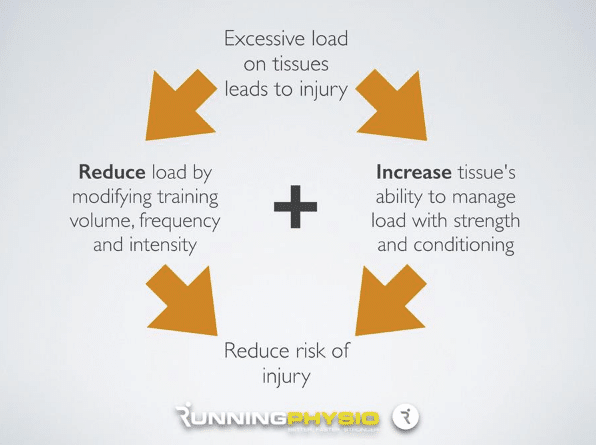
Running Load Management
Running load management is a great topic for our everyday runners.
Too often people leave their training a bit late and try and do ‘too much too soon’; they end up overloading their tissue resulting in pain and injury. Have a read below to see how to prevent those ‘niggling’ running injuries.

Training > Tissue capacity = injury
The above equation is the driving theory behind running load management; our current training load compared to the capacity of our body to handle that load. Injury happens when we get this balance wrong; often we increase our training load before our body has had time to adapt. If the load is greater than what our body can handle; the weakest link gives first.
Training load is determined by the following parameters:
- Volume [how much]
- Frequency [how often]
- Intensity [how hard]
- Type of training + Novel Activity [what we do each day]
Training error accounts for up to 80% of running related injuries. Gradual change is the key to avoid overloading the tissues; as a rule of thumb you should not increase distance by more than 10% per week. When making changes to your training regime it is important to change only ONE parameter at a time; be it distance, no of runs/week or speed.
The key to injury prevention: gradual progression allowing time for your tissues to adapt.
A previous running injury is the biggest risk factor for future injury. Post-injury the capacity of a tissue to handle load is reduced; making it more prone to re-injury. The solution; we need to gradually build up the strength of that tissue exercises. This is where our exercise physiologist comes in. They identify the tissue at fault and prescribe exercises designed to improve its strength, thereby reducing the risk of re-injury.

The old saying ‘a man is only as good as his tools’ certainly applies to running too; with the choice of footwear a minefield for every runner. There’s a lot of information out there with regards to the best type of footwear. ‘Born to Run’ by Christopher McDougall has been the driving factor behind the recent popularity ‘minimalist footwear’.
So… what shoes are best?
The true answer is there is none; there is no ‘perfect shoe’ on the market. Everyone has a different foot type and that means we shouldn’t be picking our new shoes based off what our friends have. The best thing to do is to go to a running shoe store and get properly fitted by the staff.
Been told you have flat feet?
If you have and you get sore feet when you run; try this taping technique. It’d designed to correct the biomechanical issues associated with flat feet. If it gives you a bit of relief it means it might be time to seek some professional help to work towards a long-term solution.
Pivotal Motion Physiotherapy has a fantastic video for how to tape the foot for anti-pronation which is greatly worth the watch.
Want to Learn More?
Interested to learn more about running load management? Pivotal Motion can help! Call our sports physiotherapy Brisbane team today on 07 3352 5116 or book an appointment online for physio with an integrated approach.
Updated 17/03/2021



